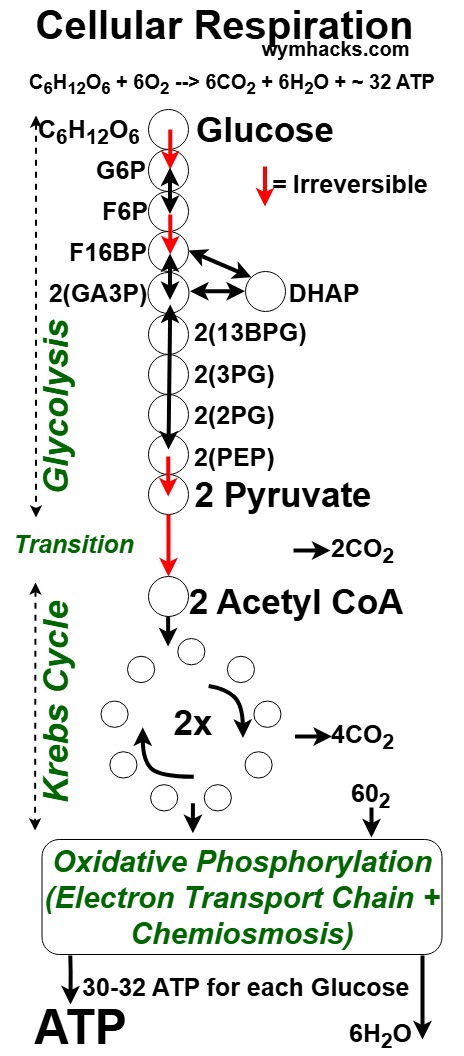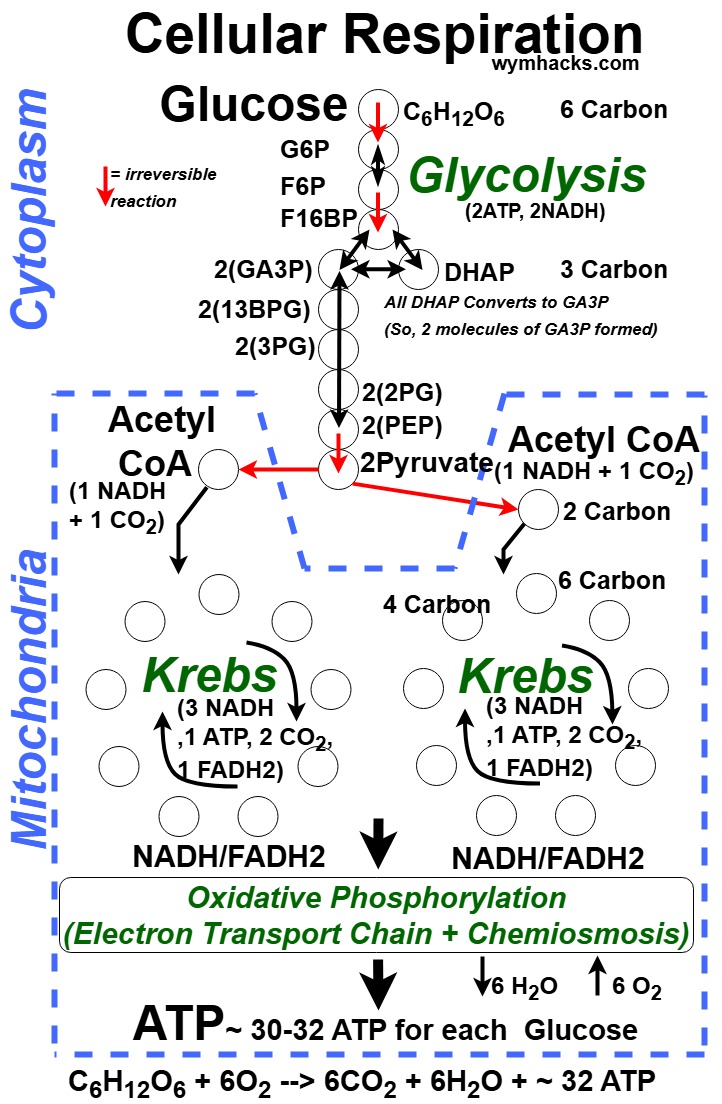Cellular Respiration
Cellular Respiration Simplified Flow Charts
Last Update: November 2, 2024
The charts below show the Cellular_Respiration reaction pathway starting with Glucose.
- Version 1 Chart is a simple template
- Version 2 Chart shows the cell locations of the reactions and the 2:1 molar relationship between Pyruvate and Glucose.
Cellular_Respiration can be seen as a core metabolic hub, connecting various catabolic and anabolic pathways.
For this reason, it’s sometimes described as Central Metabolism.
Picture Cellular Respiration Simplified Flow Chart Version 1

Picture_Cellular Respiration Simplified Flow Chart Version 2

I generated the following text (in quotations) using Google Gemeni:
“Cellular_respiration is a complex process that involves the breakdown of glucose to produce energy in the form of ATP.
Here’s a step-by-step breakdown of this process:
1. Glycolysis
- Glucose, a six-carbon sugar, is broken down into two three-carbon molecules of pyruvate.
- This process occurs in the cytoplasm of the cell and produces a net gain of 2 ATP molecules and 2 NADH molecules.
2. Pyruvate Oxidation
- Pyruvate is transported into the mitochondria.
- Each pyruvate molecule is converted into acetyl-CoA, releasing carbon dioxide and NADH.
3. Citric Acid Cycle (Krebs Cycle)
- Acetyl-CoA enters the citric acid cycle, a series of reactions that oxidizes the acetyl group to carbon dioxide.
- For each acetyl-CoA molecule, the cycle produces 2 carbon dioxide molecules, 3 NADH molecules, 1 FADH2 molecule, and 1 ATP molecule.
4. Oxidative Phosphorylation (Electron Transport Chain + Chemiosmosis)
- This is the final stage of cellular_respiration and occurs in the inner mitochondrial membrane.
- NADH and FADH2, produced in the previous steps, donate electrons to an electron transport chain.
- As electrons move through the chain, energy is released and used to pump protons across the inner mitochondrial membrane, creating a proton gradient.
- Protons flow back across the membrane through ATP synthase, driving the synthesis of ATP.
- Oxygen is the final electron acceptor in the chain, combining with protons to form water.
Overall, cellular_respiration is incredibly efficient, yielding a significant amount of ATP per glucose molecule.
This energy is essential for various cellular processes, including muscle contraction, protein synthesis, and active transport.”
Refer to my Cellular Respiration series , linked below.
- Cellular_Respiration (I) Overview
- Cellular_Respiration (II) Glycolysis
- Cellular_Respiration (III) Pyruvate to Acetyl CoA
- Cellular_Respiration (IV) Krebs Cycle
- Cellular_Respiration (V) Oxidative Phosphate Addition
Refer to these great references as well.
Videos
- Cellular respiration-khanacademy.org
- Cellular respiration introduction-khanacademy.org
- Overview of cellular respiration-khanacademy.org
- Overview of glycolysis-khanacademy.org
- Gluconeogenesis 1, Gluconeogenesis 2 – khanacedymy.org
- Krebs / citric acid cycle-khanacademy.org
- Oxidative phosphorylation and the electron transport chain-khanacademy.org
- Electron transport chain-khanacademy.org
- Oxidative phosphorylation and chemiosmosis-khanacademy.org
- ATP synthase-khanacademy.org
- Calculating ATP produced in cellular respiration-khanacademy.org
Documents
- Introduction to cellular respiration and redox-khanacademy.org
- Steps of cellular respiration-khanacademy.org
- Glycolysis-khanacademy.org
- Pyruvate oxidation-khanacademy.org
- The citric acid cycle-khanacademy.org
- Oxidative phosphorylation-khanacademy.org
- Oxidative Phosphorylation: The major energy provider of the cell-khanacademy.org
- Electron Transport Chain – UC Davis
Disclaimer: The content of this article is intended for general informational and recreational purposes only and is not a substitute for professional “advice”. We are not responsible for your decisions and actions. Refer to our Disclaimer Page.
